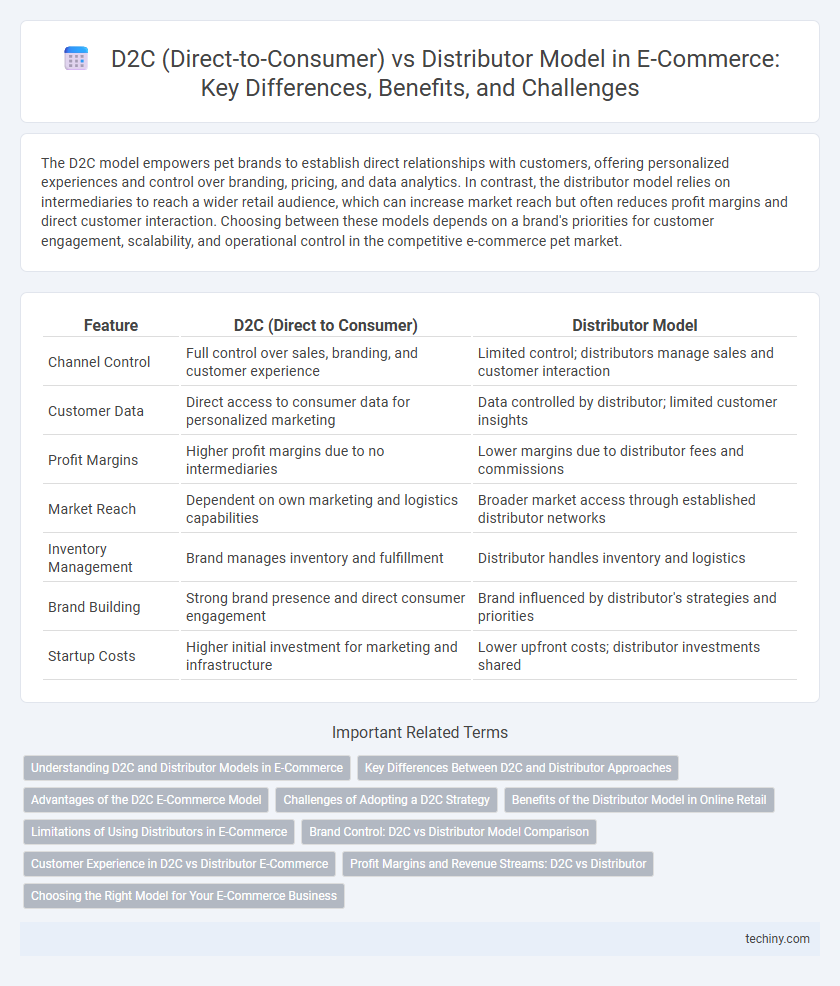The D2C model empowers pet brands to establish direct relationships with customers, offering personalized experiences and control over branding, pricing, and data analytics. In contrast, the distributor model relies on intermediaries to reach a wider retail audience, which can increase market reach but often reduces profit margins and direct customer interaction. Choosing between these models depends on a brand's priorities for customer engagement, scalability, and operational control in the competitive e-commerce pet market.
Table of Comparison
| Feature | D2C (Direct to Consumer) | Distributor Model |
|---|---|---|
| Channel Control | Full control over sales, branding, and customer experience | Limited control; distributors manage sales and customer interaction |
| Customer Data | Direct access to consumer data for personalized marketing | Data controlled by distributor; limited customer insights |
| Profit Margins | Higher profit margins due to no intermediaries | Lower margins due to distributor fees and commissions |
| Market Reach | Dependent on own marketing and logistics capabilities | Broader market access through established distributor networks |
| Inventory Management | Brand manages inventory and fulfillment | Distributor handles inventory and logistics |
| Brand Building | Strong brand presence and direct consumer engagement | Brand influenced by distributor's strategies and priorities |
| Startup Costs | Higher initial investment for marketing and infrastructure | Lower upfront costs; distributor investments shared |
Understanding D2C and Distributor Models in E-Commerce
D2C (Direct to Consumer) e-commerce models enable brands to sell products directly to customers through their own online platforms, eliminating intermediaries and increasing profit margins. Distributor models rely on third-party partners or wholesalers to reach end consumers, expanding market reach but reducing control over pricing and customer experience. Understanding these models involves evaluating factors such as customer data ownership, supply chain control, and scalability within competitive e-commerce landscapes.
Key Differences Between D2C and Distributor Approaches
D2C (Direct to Consumer) models enable brands to control the entire customer experience, from marketing to sales and fulfillment, providing real-time consumer data and higher profit margins. Distributor models rely on intermediaries to reach end customers, which can limit brand control and data access but leverage established distribution networks for broader market penetration. Pricing strategies and inventory control differ significantly, with D2C offering more flexibility in promotional campaigns and stock management compared to distributor-dependent approaches.
Advantages of the D2C E-Commerce Model
The D2C e-commerce model offers brands complete control over their customer experience, enabling personalized marketing and direct feedback collection to enhance product offerings. By eliminating intermediaries, businesses achieve higher profit margins and faster time-to-market for new products. Access to rich consumer data supports targeted advertising and inventory optimization, driving sustained growth and brand loyalty.
Challenges of Adopting a D2C Strategy
Adopting a Direct-to-Consumer (D2C) strategy presents significant challenges such as high initial investment in technology infrastructure and digital marketing to build brand visibility. Managing logistics, customer service, and data security requires specialized expertise that many traditional brands lack. Furthermore, brands face difficulties in navigating complex regulatory frameworks and handling customer acquisition costs, often higher than those in the distributor model.
Benefits of the Distributor Model in Online Retail
The distributor model in online retail enhances scalability by leveraging established distribution networks and reducing inventory risks. It enables e-commerce businesses to benefit from faster market penetration and expanded geographic reach without the overhead of direct customer service. Additionally, distributors provide valuable market insights and bulk purchasing power, optimizing supply chain efficiency and cost management.
Limitations of Using Distributors in E-Commerce
Distributors in e-commerce often create significant barriers to brand control, limiting direct access to customer data and reducing opportunities for personalized marketing. The reliance on intermediaries can result in diminished profit margins and slower response times to market trends or consumer feedback. Inconsistent branding and potential stock mismanagement further hinder the seamless customer experience essential for competitive D2C strategies.
Brand Control: D2C vs Distributor Model Comparison
The D2C (Direct to Consumer) model allows brands to maintain full control over their product presentation, pricing, and customer experience, enhancing brand consistency and loyalty. In contrast, the distributor model often limits brand control due to reliance on third-party retailers who manage sales channels and customer interactions. This reduced oversight can lead to inconsistent branding and diluted messaging, impacting overall brand equity in the e-commerce ecosystem.
Customer Experience in D2C vs Distributor E-Commerce
D2C e-commerce offers a personalized customer experience by enabling brands to control the entire buying journey, from product discovery to post-purchase support, enhancing engagement and loyalty. In contrast, the distributor model can dilute the customer experience due to limited brand control and reliance on third-party platforms, often resulting in inconsistent messaging and service quality. Direct access to customer data in D2C allows for tailored marketing and faster resolution of issues, which is less feasible in the distributor model.
Profit Margins and Revenue Streams: D2C vs Distributor
D2C (Direct to Consumer) models often yield higher profit margins by eliminating intermediaries, allowing brands to capture full retail prices and customer data. Distributor models typically involve lower margins due to wholesale pricing but benefit from broader market reach and reduced operational costs. Revenue streams in D2C rely heavily on direct sales and personalized marketing, while distributor models generate income through bulk sales and established retailer networks.
Choosing the Right Model for Your E-Commerce Business
Choosing the right model for your e-commerce business involves evaluating the benefits of Direct to Consumer (D2C) versus the distributor model, focusing on control, profit margins, and customer data ownership. D2C allows brands to maintain direct relationships with customers, enhance brand loyalty, and gather valuable consumer insights for personalized marketing. Conversely, the distributor model enables faster market penetration and reduced operational burdens but often results in lower margins and less control over customer experience.
D2C (Direct to Consumer) vs Distributor Model Infographic

 techiny.com
techiny.com